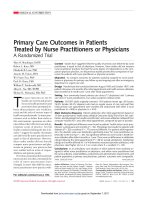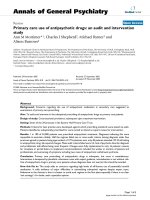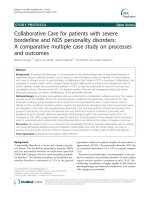Báo cáo y học: "Intensive care unit acquired muscle weakness: when should we consider rehabilitation" pps
Bạn đang xem bản rút gọn của tài liệu. Xem và tải ngay bản đầy đủ của tài liệu tại đây (45.01 KB, 2 trang )
Available online />Page 1 of 2
(page number not for citation purposes)
Abstract
Muscle weakness is highly prevalent during acute critical illness,
with the poor exercise performance that occurs after critical illness
being recognized as a consequence of skeletal muscles weakness.
Advanced techniques to measure peripheral muscle strength are
available, but they have limited use in the clinical setting. Simple
volitional methods to assess strength are limited because they rely
on patient motivation, which can be problematic in the critical care
setting. At present, the mechanisms that underlie skeletal muscle
wasting and weakness are poorly understood, but use of
rehabilitation early in critical illness appears to have beneficial
effects on outcome. The future direction will be to determine the
underlying mechanisms as well as developing rehabilitation
programmes during both the acute and the post critical illness
stages.
In this month’s issue of Critical Care, Truong and coworkers
[1] review the data on skeletal muscle dysfunction after acute
critical illness. Increasingly recognized, skeletal muscle
weakness can be commonplace in the intensive care unit
(ICU) setting, with a single centre study demonstrating that
25% of patients have muscle weakness [2]. In another study
of 116 patients [3], reduction in limb strength was associated
with respiratory muscle weakness and delayed weaning from
mechanical ventilation. These and other data have directed
the focus of health care in the UK onto rehabilitation after
critical illness, and guidelines by the National Institute of
Clinical Excellence (NICE) were recently published [4].
Identification and stratification of patients with ICU acquired
weakness (AW), who could benefit from rehabilitation, is of
fundamental importance. Nonvolitional assessments of
muscle strength, using such techniques as magnetic
stimulation of peripheral nerves, have provided detailed
physiological data that demonstrate significant reductions in
muscle strength [5-8]. However, availability of these objective
tools for assessment is limited outside the research
environment, and consequently they are of limited clinical
utility. Other measurements have been proposed, such as
hand grip strength, which are easier to perform, but such
volitional tests in critically ill patients are difficult to interpret,
especially if a borderline low normal result is obtained,
because this could indicate weakness, poor motivation or
inability to complete the task. Ali and colleagues [9] showed
that that handgrip strength can be a predictor of mortality,
although this could also be a reflection of critical illness
severity. A novel technique to consider that is relatively simple
and portable is the use of ultrasound to measure quadriceps
cross-sectional area as a nonvolitional surrogate marker of
quadriceps strength [10]. Although this has the potential to be
a clinical useful tool, the ability of ultrasound to measure cross-
sectional area sequentially in order to quantify muscle loss and
predict functional outcome remains unproven.
Although these data demonstrate the occurrence of ICU-AW,
there is a paucity of data that provide insight into the
pathophysiological mechanisms involved. Truong and
coworkers [1] identify risk factors that have been shown to be
associated with muscle weakness, and provide a summary of
the potential mechanisms of immobility and disuse related
muscle atrophy. Although these are rational explanations, our
current knowledge of the muscle atrophy/hypertrophy
signalling pathways and muscle proteolysis pathways are
mainly based on animal data. Human studies have revealed
dissociations between actual protein turnover and alterations
in signalling pathways that are purported to control protein
synthesis and breakdown [11,12]. Human studies within the
ICU setting are needed before we can begin to elucidate the
processes that underlie critical illness associated muscle
Commentary
Intensive care unit acquired muscle weakness: when should we
consider rehabilitation?
Zudin Puthucheary
1
and Nicholas Hart
2
1
Lane Fox Respiratory Unit, Department of Critical Care, Guy’s & St Thomas’ NHS Foundation Trust, Westminster Bridge Road, London SE1 7EH, UK
2
Lane Fox Respiratory Unit, Department of Critical Care, NIHR Comprehensive Biomedical Research Centre, Guy’s & St Thomas’ NHS Foundation
Trust and King’s College London, Westminster Bridge Road, London SE1 7EH, UK
Corresponding author: Nicholas Hart
Published: 20 July 2009 Critical Care 2009, 13:167 (doi:10.1186/cc7937)
This article is online at />© 2009 BioMed Central Ltd
See related review by Truong et al., />AW = acquired weakness; ICU = intensive care unit.
Critical Care Vol 13 No 4 Puthucheary and Hart
Page 2 of 2
(page number not for citation purposes)
loss. From this, muscle and other biomarkers could potentially
identify those patients who are at risk for major functional
limitation who would benefit the most from interventions such
as rehabilitation.
Despite our limited mechanistic knowledge, skeletal muscle
weakness has been shown to be an independent predictor of
mortality in stable patients with chronic obstructive pulmonary
disease and chronic heart failure, with rehabilitation improving
outcome [13-16]. Although exercise in these patients is often
carried out during stable periods, Truong and coworkers [1]
challenge the view that ICU patients receiving invasive
mechanical ventilation should be excluded from mobilization,
highlighting a low incidence of adverse events. However, we
must influence the culture within critical care to promote
these changes.
Recently, Schweickert and colleagues [17] demonstrated the
safety and efficacy of combined sedation holds and whole
body rehabilitation during the early stages of critical illness.
These interventions were conducted by a multidisciplinary
team in centres that did not routinely provide physical therapy
at the early stages of mechanical ventilation, demonstrating
better functional outcome at hospital discharge. As always
within the context of a clinical trial, strict exclusion criteria
preclude this study from being wholly generalizable,
especially because these data pertain only to medical ICU
patients. Despite significant differences in the delivery of
physical therapy rehabilitation services in ICUs in different
countries, these data show that critically ill patients can safely
receive early rehabilitation therapy with improved outcomes.
The next challenge is to unravel the pathophysiology of this
acquired skeletal muscle disease and to develop further
intervention strategies, including clinical trials investigating
the effects of rehabilitation after critical illness.
Competing interests
The authors declare that they have no competing interests.
References
1. Truong AD, Fan E, Brower RG, Needham DM: Mobilizing
patients in the intensive care unit: from pathophysiology to
clinical trials. Crit Care 2009, 13:216.
2. De Jonghe B, Sharshar T, Lefaucheur JP, Authier FJ, Durand-
Zaleski I, Boussarsar M, Cerf C, Renaud E, Mesrati F, Carlet J,
Raphaël JC, Outin H, Bastuji-Garin S; Groupe de Réflexion et
d’Etude des Neuromyopathies en Réanimation: Paresis acquired
in the intensive care unit: a prospective multicenter study.
JAMA 2002, 288:2859-2867.
3. De Jonghe B, Bastuji-Garin S, Durand MC, Malissin I, Rodrigues
P, Cerf C, Outin H, Sharshar T; Groupe de Réflexion et d’Etude
des Neuromyopathies en Réanimation: Respiratory weakness is
associated with limb weakness and delayed weaning in criti-
cal illness. Crit Care Med 2007, 39:2007-2015.
4. NICE: CG83 Critical illness rehabilitation. 2009
[ />5. Harris ML, Moxham J. Measuring respiratory and limb muscle
strength using magnetic stimulation: Measuring respiratory and
limb muscle strength using magnetic stimulation. Br J Inten-
sive Care 1998, 8:21-28.
6. Harris ML, Luo YM, Watson AC, Rafferty GF, Polkey MI, Green M,
Moxham J: Adductor pollicis twitch tension assessed by mag-
netic stimulation of the ulnar nerve. Am J Respir Crit Care Med
2000, 162:240-245.
7. Mills GH, Ponte J, Hamnegard CH, Kyroussis D, Polkey MI,
Moxham J, Green M: Tracheal tube pressure change during
magnetic stimulation of the phrenic nerves as an indicator of
diaphragm strength on the intensive care unit. Br J Anaesth
2001, 87:876-884.
8. Watson AC, Hughes PD, Louise Harris M, Hart N, Ware RJ,
Wendon J, Green M, Moxham J: Measurement of twitch transdi-
aphragmatic, esophageal, and endotracheal tube pressure
with bilateral anterolateral magnetic phrenic nerve stimulation
in patients in the intensive care unit. Crit Care Med 2001, 29:
1325-1331.
9. Ali NA, O’Brien JM Jr, Hoffmann SP, Phillips G, Garland A, Finley
JC, Almoosa K, Hejal R, Wolf KM, Lemeshow S, Connors AF Jr,
Marsh CB; Midwest Critical Care Consortium: Acquired weak-
ness, handgrip strength and mortality in critically ill patients.
Am J Respir Crit Care Med 2008, 178:261-268.
10. Seymour JM, Ward K, Sidhu P, Puthucheary Z, Steier J, Jolley C,
Rafferty G, Polkey MI, Moxham J: Ultrasound measurement of
rectus femoris cross-sectional area and the relationship to
quadriceps strength in chronic obstructive pulmonary
disease. Thorax 2009, 64:418.
11. Greenhaff PL, Karagounis LG, Peirce N, Simpson EJ, Hazell M,
Layfield R, Wackerhage H, Smith K, Atherton P, Selby A, Rennie
MJ: Disassociation between the effects of amino acids and
insulin on signaling, ubiquitin ligases, and protein turnover in
human muscle. Am J Physiol Endocrinol Metab 2008, 295:
E595-E604.
12. Murton AJ, Constantin D, Greenhaff PL: The involvement of the
ubiquitin proteasome system in human skeletal muscle
remodelling and atrophy. Biochim Biophys Acta 2008, 1782:
730-743.
13. Troosters T, Gosselink R, Decramer M. Short- and long-term
effects of outpatient rehabilitation in patients with chronic
obstructive pulmonary disease: a randomized trial. Am J Med
2000;109:207.
14. Williams MA, Ades PA, Hamm LF, Keteyian SJ, LaFontaine TP,
Roitman JL, Squires RW. Clinical evidence for a health benefit
from cardiac rehabilitation: an update.
Am Heart J 2006, 152:
835
15. Troosters T, Gosselink R, Decramer M: Chronic obstructive pul-
monary disease and chronic heart failure: two muscle dis-
eases? J Cardiopulm Rehabil 2004, 24:137-145.
16. Swallow EB, Reyes D, Hopkinson NS, Man WD, Porcher R, Cetti
EJ, Moore AJ, Moxham J, Polkey MI: Quadriceps strength pre-
dicts mortality in patients with moderate to severe chronic
obstructive pulmonary disease. Thorax 2007, 62:115-120.
17. Schweickert WD, Pohlman MC, Pohlman AS, Nigos C, Pawlik AJ,
Esbrook CL, Spears L, Miller M, Franczyk M, Deprizio D, Schmidt
GA, Bowman A, Barr R, McCallister KE, Hall JB, Kress JP: Early
physical and occupational therapy in mechanically ventilated,
critically ill patients: a randomised controlled trial. Lancet
2009, 373:1874-1882.









